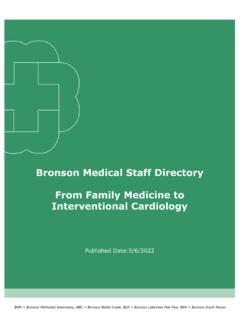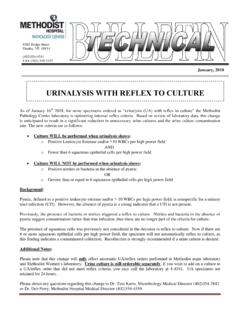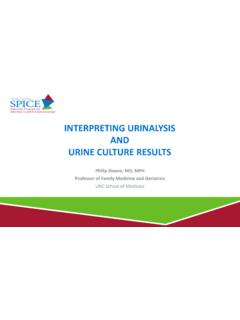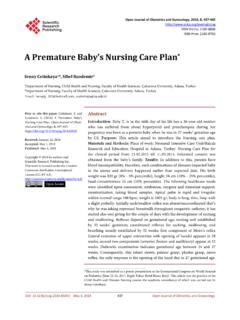Transcription of New Serology Panel for SARS -CoV-2 (COVID-19) Antibodies
1 Laboratory News and Analysis for Clinicians February 2021 New Serology Panel for SARS -CoV-2 (COVID-19) Antibodies Effective: February 23, 2021 Since May of 2020, Bronson Laboratory has offered a test for total Antibodies (IgM, IgG and IgA) to the nucleocapsid (capsid) protein of the SARS -CoV-2 virus. All SARS -CoV-2 viruses contain the capsid antigen and people who are infected or recovered from infection have Antibodies to this antigen. The Antibodies are not present in people who have never been infected or in those who have received the COVID-19 vaccine. The current and forthcoming COVID-19 vaccines all consist of the spike protein only, and none contain the capsid protein. The test is qualitative and reported as either positive or negative.
2 Additional details on this test were published in the May 2020 LabWire. Recently a new test has been authorized by the FDA (under an Emergency Use Authorization) for Antibodies specific to the spike protein of this virus. Some features of this test include: This test is positive in individuals who have either been infected by or vaccinated for COVID-19 The test detects total Antibodies (IgG, IgM and IgA) to the SARS -CoV-2 spike protein Nearly 100% of individuals have detectable spike antibody within 14 days of infection or immunization Samples collected sooner than 14 days may give false negative results The analytical specificity when tested against 1,100 pre-pandemic samples positive for other coronavirus Antibodies was 100% 1 (the test did not cross-react with other Coronaviruses) This test gives a numeric result in U/mL.
3 Because there is no international standard for quantifying coronavirus Antibodies , the FDA has classified the test as semi-quantitative but a higher number denotes a higher level of Antibodies Validation studies determined that a value greater or equal to U/mL is a positive result (spike protein Antibodies were detected) The upper range of the reported results will be 250 U/mL; specimens above that level will be reported as >250 U/mL Internal dilution studies have shown that many individuals have values in excess of 2,500 U/mL after their 2nd dose of mRNA vaccine Monthly test positivity rate over the past year is displayed at left and shows that providers are using the test to detect current and previously infected patients.
4 Laboratory News and Analysis for Clinicians February 2021 SARS -CoV-2 Antibodies (cont.) Bronson Laboratory will offer the two SARS -CoV-2 virus Serology tests as a Panel called COVID-19 Ab Panel Epic LAB3778 or Sunquest C19 ABP. Combining the two tests into a Panel allows for better determination of a patient s serological picture: Capsid Antibody Spike Antibody Status Negative Negative Indicates neither vaccination nor infection Negative Positive Indicates vaccination; no evidence of infection Positive Negative Indeterminate. Could be early post infection or possible non-specific false positive Positive Positive Indicates infection with or without vaccination Limitations of the test continue to be our lack of knowledge of how long detectable Antibodies persist in the patient following either infection or immunization.
5 We do not know what levels of Antibodies indicate immunity or protection from infection, but preliminary studies suggest that the presence of anti-spike or anti-nucleocapsid IgG Antibodies is associated with a substantially reduced risk of SARS -CoV-2 reinfection in the ensuing 6 months. 2 The current applications and clinical utility for COVID-19 Serology testing include: Seroprevalence and epidemiological studies Diagnosis of individuals who may have been infected more than 14 days before testing, after the virus may no longer be detectable by PCR or antigen tests Distinguishing whether a patient s positive SARS -CoV-2 PCR test represents current infection ( Serology test should be negative) or past infection ( Serology test should be positive) Identification of individuals who may serve as potential convalescent plasma donors.
6 References 1) Elecsys Anti-SARS -CoV-2 S Emergency Use Authorization package insert, Roche Diagnostics, Indianapolis, IN 2) Lumley, SF, Antibody Status and Incidence of SARS -CoV-2 Infection in Health Care Workers, The New England Journal of Medicine, Dec 23, 2020 Laboratory News and Analysis for Clinicians February 2021 Situation: The introduction of new urinalysis technology in our system has provided the opportunity to streamline our workflow and provide the right testing to the right patient at the right time. Beginning on March 23, Bronson Laboratories will move to a reflex urine microscopic workflow. Background: Urine chemical analysis and microscopic analysis are currently performed on all UA and UAIFF orders using separate instruments.
7 While both instruments are automated, microscopic analysis takes longer and more often requires technician input, which extends turnaround time. Recent publications suggest limiting microscopic examination to samples with abnormal chemical analysis improves turnaround time with minimal impact on the detection of pathogenic urinary tract infections 1. Proposed criteria for reflex to urine microscopic examination include: Positive leukocyte esterase Positive hemoglobin Positive nitrite Positive protein Positive glucose Non-clear appearance. Abnormalities in any one urine chemical analyte would result in a reflex to urine microscopic examination. Criteria designed to be overly inclusive to ensure abnormal urines proceed to urine microscopic examination.
8 Criteria for reflex to urine culture would be unchanged: Moderate or large leukocyte esterase Positive nitrite >9 WBCs/HPF 2+, 3+, or 4+ bacteria A retrospective analysis of UA and UAIFF orders was undertaken to ensure the above workflow would not significantly alter detection of pathogenic organisms. 11,005 consecutive UAIFFs ordered between 10/10 and 12/10 were reviewed. Both chemical and microscopic analyses were performed on all specimens.
9 Of 11,005 samples, 3,774 were cultured ( ) under the old workflow. Had microscopic examination been performed as a reflex test, 3,721 samples would be cultured ( ). Review of the 53 samples that would not have proceeded to culture revealed a majority with normal urogenital flora or no growth (35 samples). Eighteen contained possible pathogens. The altered workflow resulted in 3004 fewer urine microscopic examinations. Our takeaway was that significantly fewer urine microscopic examinations could be performed (~27%) with little impact the sensitivity of UAIFF order to pathogenic organisms (False negative rate ). Figure 1. UAIFF Outcomes with reflex Urine Microscopy Compared to Mandatory Microscopy N=11005. Introduction of New Urinalysis Technology Laboratory News and Analysis for Clinicians February 2021 New Urinalysis Technology (cont.)
10 Assessment: Performing urine microscopic analysis as a reflex to urine chemical analysis results in a significant time savings with little impact to the sensitivity of the UAIFF order to detect pathogenic organisms. Resolution: Urine microscopic examination performed as a reflex to urine chemical analysis on all UA and UAIFF orders. References 1) Chambliss AB, Mason HM, Van TT. Correlation of Chemical Urinalysis to Microscopic Urinalysis and Urine culture : Implications for reflex Urinalysis Workflows. J Appl Lab Med. 2020 Jul 1;5(4):724-731. doi: PMID: 32603438. Patients Can Now Secure Their Place In Line for Lab and X-ray Services While walk-in visits have always been available for X-ray and lab services, patients can now choose to walk in for these services or, for added convenience, let us know they re on their way and we can hold their place in line.








